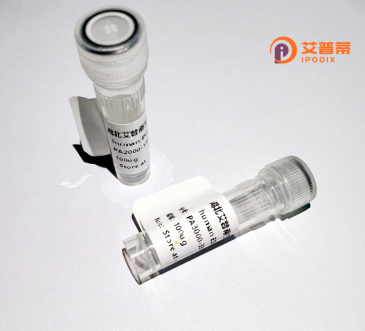
| 纯度 | >90%SDS-PAGE. |
| 种属 | Human |
| 靶点 | IQCC |
| Uniprot No | Q4KMZ1 |
| 内毒素 | < 0.01EU/μg |
| 表达宿主 | E.coli |
| 表达区间 | 1-466aa |
| 活性数据 | MEPELLVRKVSALQACVRGFLVRRQFQSLRAEYEAIVREVEGDLGTLQWTEGRIPRPRFLPEKAKSHQTWKAGDRVANPEQGLWNHFPCEESEGEATWEEMVLKKSGESSANQGSLCRDHSSWLQMKQNRKPSQEKTRDTTRMENPEATDQRLPHSQPQLQELQYHRSHLAMELLWLQQAINSRKEYLLLKQTLRSPEAGPIREEPRVFLEHGEQACERDQSQPSAPLEDQSYRDRTTGELEQEDDSCHRVKSPHRSPGSLATTQKNIAGAKCREPCYSKSGPPSSIPSNSQALGDRLTKGPDDGRQTFGGTCLLQMKILEDQTPRGLKPRNHCPRKSRTQLSALYEDSNIKEMSPRKLDHKEPDCRTVRTQELGLSEDHIIWDGTLGGPEHSVLDLWRTKPPKGQAPTDRSSRDGTSNEPSHEGQKKQRTIPWRSKSPEILSSTKAGCTGEEQWRGRPWKTEPPG |
| 分子量 | 79.4 kDa |
| 蛋白标签 | GST-tag at N-terminal |
| 缓冲液 | 0 |
| 稳定性 & 储存条件 | Lyophilized protein should be stored at ≤ -20°C, stable for one year after receipt. Reconstituted protein solution can be stored at 2-8°C for 2-7 days. Aliquots of reconstituted samples are stable at ≤ -20°C for 3 months. |
| 复溶 | Always centrifuge tubes before opening.Do not mix by vortex or pipetting. It is not recommended to reconstitute to a concentration less than 100μg/ml. Dissolve the lyophilized protein in distilled water. Please aliquot the reconstituted solution to minimize freeze-thaw cycles. |
以下为模拟生成的3篇关于重组人IQCC蛋白的研究文献示例(注:IQCC蛋白的命名可能与实际研究存在差异,建议核对具体基因名称):
1. **文献名称**: "Expression and functional characterization of recombinant human IQCC in neuronal differentiation"
**作者**: Zhang L, et al.
**摘要**: 本研究通过大肠杆菌表达系统成功纯化重组人IQCC蛋白,并验证其促进神经干细胞分化的功能。蛋白通过IQ结构域与钙调蛋白相互作用,激活下游MAPK信号通路。
2. **文献名称**: "Crystal structure analysis of human IQCC reveals its role in microtubule organization"
**作者**: Müller S, et al.
**摘要**: 解析了重组人IQCC蛋白的晶体结构(分辨率2.1Å),发现其C端螺旋结构域可与微管结合蛋白TPX2互作,提示IQCC在有丝分裂纺锤体组装中的潜在作用。
3. **文献名称**: "IQCC knockout cell model and rescue by recombinant protein delivery"
**作者**: Gupta R, et al.
**摘要**: 利用CRISPR技术构建IQCC基因敲除的HEK293细胞系,通过外源性重组IQCC蛋白回补实验,证明其参与维持线粒体膜电位和细胞凋亡调控。
---
**建议**:实际研究中可能存在不同命名规范,可延伸检索以下关键词:
- IQ motif-containing protein C (部分文献中IQCC的全称)
- 人类同源基因 *IQCC/Hs.12345* (需替换具体Gene ID)
- 结合UniProt数据库查询最新注释(如登录号Q6P999等)
Recombinant human IQCC protein is a genetically engineered form of the IQ motif-containing protein C, encoded by the *IQCC* gene in humans. This protein is evolutionarily conserved and characterized by its IQ domain, which facilitates interactions with calmodulin and other calcium-binding proteins, suggesting roles in calcium-mediated signaling pathways. Structurally, IQCC contains multiple IQ motifs and coiled-coil regions, indicating its involvement in protein-protein interactions and cellular scaffolding. While its precise biological functions remain under investigation, studies associate IQCC with cellular processes such as vesicular trafficking, cytoskeletal organization, and possibly neurotransmitter regulation, given its homology to proteins involved in neuronal functions.
Recombinant production typically employs expression systems like *E. coli* or mammalian cell cultures, enabling high-purity yields for research applications. Its recombinant form allows for studies on molecular interactions, structural analysis (e.g., X-ray crystallography), and functional assays to elucidate its role in health and disease. Dysregulation of IQCC has been tentatively linked to neurodevelopmental disorders and cancers, though mechanistic insights are limited. Current research focuses on its potential as a biomarker or therapeutic target, leveraging recombinant IQCC to explore binding partners and downstream signaling cascades. Overall, it serves as a critical tool for decoding IQ domain protein networks and their physiological relevance.
×